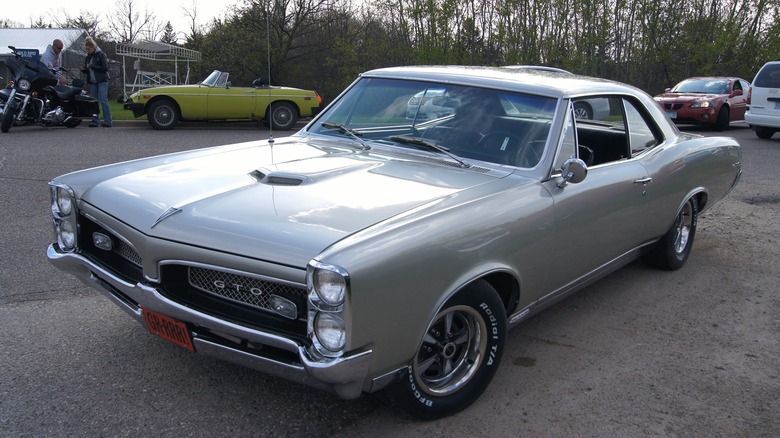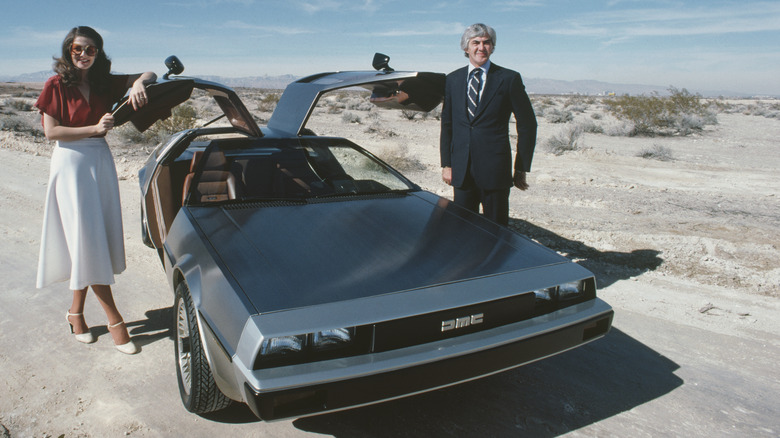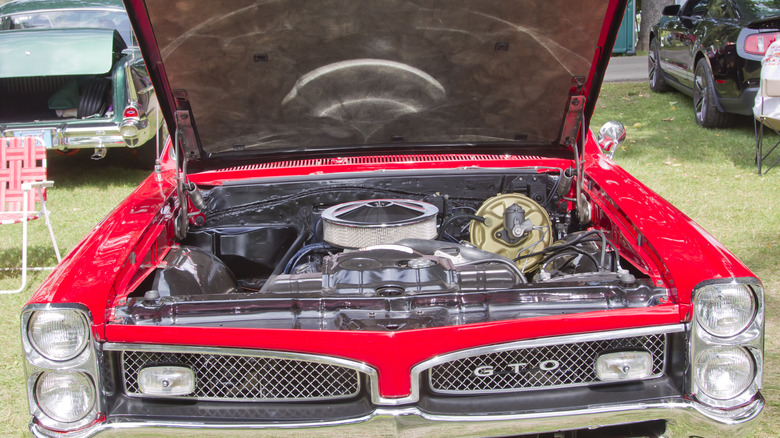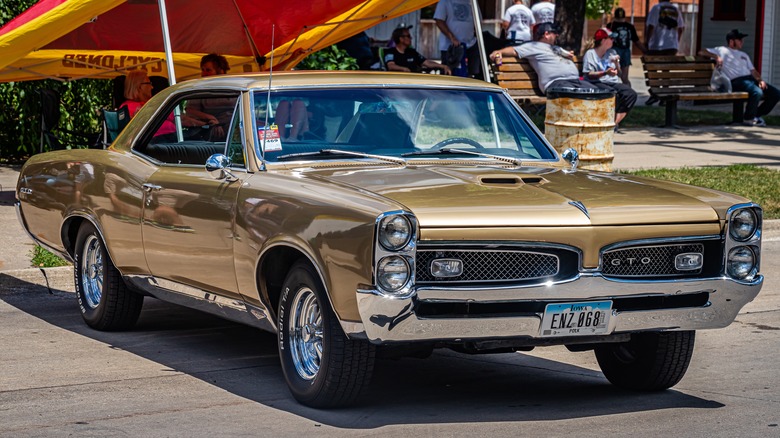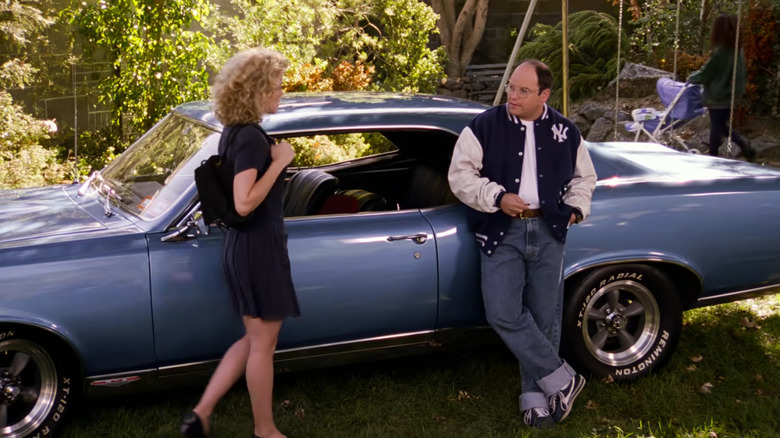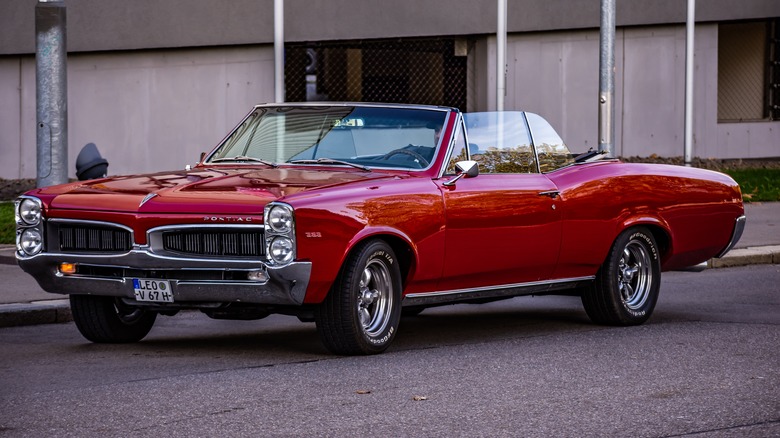5 Facts About The 1967 Pontiac GTO Only Hardcore Car Fans Know
The Pontiac GTO first appeared in 1964 as an option package for the LeMans. It didn't take long, though, for the name to catch on, and the GTO quickly became a legendary part of muscle car history. The first generation lasted through 1967, during which the GTO underwent some cosmetic redesigns. In 1965, Pontiac added a hood scoop and stacked the headlights, and the next year, the GTO got its own nameplate and sold nearly 100,000 units.
For 1967, the more subtle evolutions included a switch to an eight-piece taillight array and a new latticework grille. But the biggest changes were under the GTO's massive hood. The GTO's 389 cubic-inch V8 was expanded out to 400 cubic inches, and the tri-power (three two-barrel carburetor) setup was ditched for a Rochester four-barrel. The new carburetor wasn't something Pontiac's engineers wanted, but starting in 1967, GM barred multiple carbs on anything that wasn't a Corvette.
In the years after, the 1967 GTO cemented itself in American automotive history. Here are some things you might not know about the beloved Pontiac muscle car.
[Featured image by Greg Gjerdingen via Wikimedia Commons|Cropped and scaled|CC-BY 2.0]
John DeLorean created the GTO
Most people associate John DeLorean with the silver gull-winged car that bears his name and starred in the "Back to the Future" films, but he had a long career with General Motors before he started the DeLorean Motor Company. DeLorean was born in Detroit and earned an engineering degree in 1948 despite taking a break to fight in World War II. DeLorean worked at Chrysler and Packard until 1956 when Bunkie Knudsen hired him away to Pontiac, which was losing ground to other brands at the time. DeLorean was a creative force at Pontiac, inventing hideaway windshield wipers and securing multiple automotive patents.
DeLorean anticipated the explosion in demand for high-performance cars, but GM's upper management was nervous about a looming government antitrust suit. The company had also instituted an engine size limit of one cubic inch per 10 pounds of curb weight. DeLorean and his team realized that this limit applied to new models but not to option packages, so the W62 GTO package was added to the Tempest's option sheet. Pontiac dealers took 5,000 orders before GM's top brass got wise. By year's end, more than 32,000 had been sold, and GM couldn't kill the goose that laid the golden egg. By 1967, the suits had warmed to the GTO's appeal, and Trans Am racing success revived GM's interest in producing high-performance cars again. DeLorean stayed with Pontiac long enough to craft the Firebird and Grand Prix before going off on his own in 1973.
The GTO's 400 cubic-inch engine came in several variants
Although the one and only engine option in the 1967 Pontiac GTO was the aforementioned 400 cubic-inch V8, it came in three configurations. An economy version with a two-barrel carburetor made 255 horsepower and delivered just over 10 miles per gallon on average while launching the 3,648-pound hardtop version from 0-60 in 8.1 seconds.
The standard setup had a thirstier four-barrel carburetor that increased output to 335 horses, cut the 0-60 time to 5.7 seconds, and dropped fuel economy under the 10 miles-per-gallon mark. A high-output setup included tuning and timing tweaks that upped capacity to 360 horsepower and made the engine about a mile and a half per gallon thirstier. The $77 HO package also included an upgraded exhaust system, a hot cam, and a high-flow air cleaner.
Fewer than 14,000 of the 82,000 or so '67 GTOs had the HO option. The next step up was the $263 Ram Air package, which included beefier valve springs and all the gear needed to connect the previously ornamental hood scoop to the air intake.
The 1967 GTO was faster than a Mustang GT-500
Muscle machines were everywhere in the late '60s, but if you had a 1967 GTO, you'd be able to beat almost anyone in a drag race. Motor Trend clocked the manual transmission model at 4.9 seconds from 0-60 and the automatic at about 13.4 seconds for a quarter mile. About the only production car that was faster that year was the Corvette Stingray, which could get from 0-60 in 4.7 seconds with the help of its 427 cubic-inch V8. Ford's best mainstream effort was the Mustang Shelby GT-500, but that beast was left in the GTO's exhaust cloud with a 0-60 time of 6.5 seconds and a quarter-mile pace of 15 seconds flat.
A handful of 1967 Mopar models had 440-inch Hemi V8s under their hoods, but that monster still took 6.6 seconds to get the Plymouth GTX from 0-60. The fastest car on the road that year was the Ford Shelby Cobra, which could smoke all of the above with its LeMans-dominating 427 cubic-inch motor, lightweight chassis, and 0-60 time of four seconds flat. You rarely would have found yourself wheel-to-wheel with a 427 Cobra, though, as few were ever made.
The '67 GTO is a pop culture icon
The '67 GTO's sweeping lines and timeless appeal have made it a staple on television and movie screens. It appeared on contemporary shows like "I Dream of Jeannie" and "Mannix," in movie classics like "The French Connection," and even as the chosen ride of faux bad boy George Costanza on the fourth episode of "Seinfeld" Season 8.
The GTO was also immortalized in song, although there are two common misconceptions surrounding the best-known ode to the GTO. The song is usually referred to as "Little GTO" based on the phrase used throughout, but the song is actually simply called "GTO." While the Beach Boys' version is likely familiar to many, the song was originally recorded by Ronny and the Daytonas, who took it to No. 7 on the Billboard Hot 100 in September of 1964. Their version even earned gold record status by selling more than a million copies.
Only about 1/8 of '67 GTOs are convertibles
The GTO's best sales year was 1966 with 96,946 units sold, but the 1967 model didn't lag too far behind. Pontiac made just under 82,000 '67 GTOs, and it's hard to imagine any of them sitting on dealership lots for long. Sadly, only about 9,500 of those were in the stunning convertible body style. Perhaps Pontiac sensed the era's public obsession with hairstyles and knew the hardtop versions would sell better for a coiffure-focused public.
Rollover concerns certainly weren't high on the list for a car that was a titanic 17 feet long, six feet three inches wide, and weighed more than 3,400 pounds. As you would expect, the rarity of the '67 GTO convertible back then makes it a scorching hot commodity today. While a little due diligence will uncover an assortment of '67 GTO hardtops in the $25,000 to $30,000 range, convertibles are usually priced above the $45,000 mark. A blue convertible with a Chevy LS engine swapped in ahead of a six-speed manual transmission went for $112,000 in October 2023.
